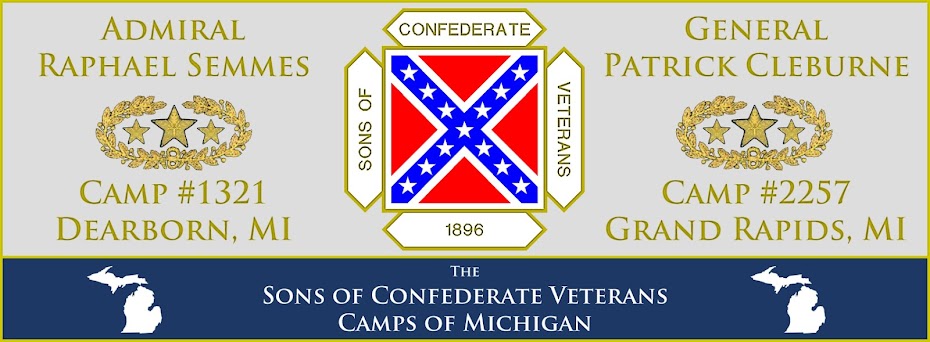=========================================================================
[Happy to present the following from Cmdr. Jim Perkins, Maj.Gen. Patrick R. Cleburne Camp #2257 (Grand Rapids, MI). Many thanks to Cmdr. Perkins for sharing this with all of our readers! - J.M.]
=========================================================================
CONFEDERATE MEMORIAL DAY, CHATTANOOGA 2016
[Happy to present the following from Cmdr. Jim Perkins, Maj.Gen. Patrick R. Cleburne Camp #2257 (Grand Rapids, MI). Many thanks to Cmdr. Perkins for sharing this with all of our readers! - J.M.]
=========================================================================
 |
| [Image courtesy of Jim Perkins] |
For Confederate Memorial Day I visited the old Confederate Cemetery in Chattanooga, where General Nathan Bedford Forrest Camp #3 held a ceremony for three Confederate veterans, two from Alabama and one from Arkansas. One of these men was my cousin Captain Sidney F. Lister.
 |
| [Image courtesy of Jim Perkins] |
A TRIBUTE TO CAPTAIN SIDNEY LISTER, 58TH ALABAMA VOLUNTEER INFANTRY
- by Jim Perkins
Sidney F. Lister was born in 1838, the second son and one of six children of Samuel and Delila Morgan Lister in St. Clair County, Alabama. Only nineteen years prior, Alabama had become a state, and the Listers were in many ways typical of early settlers in St. Clair County, which is located just east of Birmingham. Settlers there tended to be former Pennsylvanians and South Carolinians.
By 1850, Sidney was twelve years of age, and his father Samuel owned $700 worth of real estate. In 1854, the sovereign state of Alabama established public schools, however, little money was allocated for education during that time. Quite possibly the fact that Sidney’s own mother, Delila could not read or write, factored into his decision to become a school teacher near Ashville in 1859.
In 1859, Alabama ranked only second to Mississippi in cotton production, and the 1860 Census indicated that Sidney’s father, Samuel’s real estate was valued at $2,000, while his personal state was worth $6,600 (about $176,000 today), including six slaves. Furthermore, in 1860 Sidney married Louisa Neely on 27 November, and later they had one child, Albert in 1861.
It is interesting that St. Clair County lies within the Coosa River Valley where steamboats frequently cruised in order to load thousands of cotton bales from the numerous planters in the area. Between the years of 1850 and 1860, land values tripled in the valley, as the world demand for finished cotton goods exploded. With England’s textile mills operating at full bore, seventy-five percent of the cotton purchased there was the high quality product supplied by the Southern states.
Unfortunately, during this time the over-bearing, powerful, and greedy industrial hierarchy of the Northeast, coupled with the hypocritical New England Radical Republican Congressmen, stepped up their ruthless attack on the South. Consequently, the election of Abraham Lincoln in 1860 proved that the South had lost he voice in government. Therefore, on 11 January, Alabama became the fourth state to cast her lot with the Confederacy.
 |
| [Image courtesy of Jim Perkins] |
By late March, the Yankee army under U.S. Grant invaded Tennessee, and Lt. Lister saw his first action at the Battle of Shiloh, and following the first day the 18th Alabama, under the command of Brigadier J.K. Jackson, was detailed to remove Federal prisoners to the rear. Later in 1862, the 18th was transferred to Mobile until later returning to the Army of Tennessee in March 1863. During this period, Sidney Lister was promoted to Captain of the newly formed 58th Alabama Infantry, Company F.
At Chickamauga in September, the 58th under the command of William Bate, was recognized for gallantry on the field for capturing a Yankee cannon, however, the bloody battle was costly as the 58th lost 480 man, or 56% of the regiment. Following the Confederate victory at Chickamauga, the Federals retreated to Chattanooga, where the Army of Tennessee eventually surrounded them. The Battle of Missionary Ridge, fought on 25 November 1863 in Chattanooga, proved to be Captain Lister’s final battle. While defending the extreme Confederate left, and serving under Brigadier H. D. Clayton, the last mention of Sidney was noted in Colonel Inzer’s diary: “Before a great while, I discovered the enemy was flanking us on the left. He was coming up a hollow some 100 yards from the left of our regiments, moving by the flank (Capt. Lister first called my attention to the fact). It was during this portion of the fight that Sidney Lister caught a Yankee minie ball below his left knee, that shattered his fibula.
Seriously wounded, Captain Lister became a prisoner following the army’s retreat, underwent an amputation of the left leg, and ligation of the damaged artery. Thirteen days later, Sidney F. Lister passed away due to gangrene infection, and was subsequently buried near in the Confederate cemetery along the Tennessee River in Chattanooga.
 |
| [Image courtesy of Jim Perkins] |
 |
| [Image courtesy of Jim Perkins] |

No comments:
Post a Comment
Comments and questions are most welcome, but keep in mind that this is not a forum for debate. Keep all comments respectful, clean (no "foul language"), and on topic of the post. If you need information about the camps, the SCV, or how to join this organization, please refer to the links provided in the sidebar on the right of the page. Thanks!